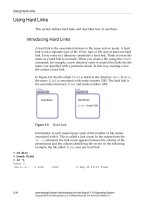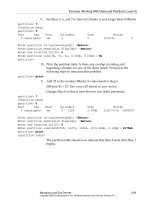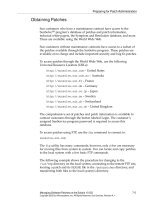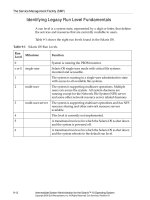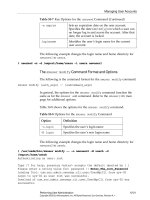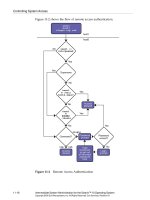System Administration Guide Oracle® Solaris 9 Containers phần 1 doc
Bạn đang xem bản rút gọn của tài liệu. Xem và tải ngay bản đầy đủ của tài liệu tại đây (848.89 KB, 10 trang )
System Administration Guide: Oracle®
Solaris 9 Containers
Part No: 820–4490–14
April 2011
Copyright © 2008, 2011, Oracle and/or its aliates. All rights reserved.
License Restrictions Warranty/Consequential Damages Disclaimer
This software and related documentation are provided under a license agreement containing restrictions on use and disclosure and are protected by intellectual
property laws. Except as expressly permitted in your license agreement or allowed by law, you may not use, copy, reproduce, translate, broadcast, modify, license,
transmit, distribute, exhibit, perform, publish or display any part, in any form, or by any means. Reverse engineering, disassembly, or decompilation of this software,
unless required by law for interoperability, is prohibited.
Warranty Disclaimer
The information contained herein is subject to change without notice and is not warranted to be error-free. If you nd any errors, please report them to us in writing.
Restricted Rights Notice
If this is software or related documentation that is delivered to the U.S. Government or anyone licensing it on behalf of the U.S. Government, the following notice is
applicable:
U.S. GOVERNMENT RIGHTS
Programs, software, databases, and related documentation and technical data delivered to U.S. Government customers are "commercial computer software" or
"commercial technical data" pursuant to the applicable Federal Acquisition Regulation and agency-specic supplemental regulations. As such, the use, duplication,
disclosure, modication, and adaptation shall be subject to the restrictions and license terms set forth in the applicable Government contract, and, to the extent
applicable by the terms of the Government contract, the additional rights set forth in FAR 52.227-19, Commercial Computer Software License (December 2007).
Oracle America, Inc., 500 Oracle Parkway, Redwood City, CA 94065.
Hazardous Applications Notice
This software or hardware is developed for general use in a variety of information management applications. It is not developed or intended for use in any inherently
dangerous applications, including applications that may create a risk of personal injury. If you use this software or hardware in dangerous applications, then you shall
be responsible to take all appropriate fail-safe, backup, redundancy, and other measures to ensure its safe use. Oracle Corporation and its aliates disclaim any
liability for any damages caused by use of this software or hardware in dangerous applications.
Trademark Notice
Oracle and Java are registered trademarks of Oracle and/or its aliates. Other names may be trademarks of their respective owners.
Intel and Intel Xeon are trademarks or registered trademarks of Intel Corporation. All SPARC trademarks are used under license and are trademarks or registered
trademarks of SPARC International, Inc. AMD, Opteron, the AMD logo, and the AMD Opteron logo are trademarks or registered trademarks of Advanced Micro
Devices. UNIX is a registered trademark of The Open Group in the United States and other countries.
Third Party Content, Products, and Services Disclaimer
This software or hardware and documentation may provide access to or information on content, products, and services from third parties. Oracle Corporation and
its aliates are not responsible for and expressly disclaim all warranties of any kind with respect to third-party content, products, and services. Oracle Corporation
and its aliates will not be responsible for any loss, costs, or damages incurred due to your access to or use of third-party content, products, or services.
Copyright © 2008, 2011, Oracle et/ou ses aliés. Tous droits réservés.
Ce logiciel et la documentation qui l’accompagne sont protégés par les lois sur la propriété intellectuelle. Ils sont concédés sous licence et soumis à des restrictions
d’utilisation et de divulgation. Sauf disposition de votre contrat de licence ou de la loi, vous ne pouvez pas copier, reproduire, traduire, diuser, modier, breveter,
transmettre, distribuer, exposer, exécuter, publier ou acher le logiciel, même partiellement, sous quelque forme et par quelque procédé que ce soit. Par ailleurs, il est
interdit de procéder à toute ingénierie inverse du logiciel, de le désassembler ou de le décompiler, excepté à des ns d’interopérabilité avec des logiciels tiers ou tel que
prescrit par la loi.
Les informations fournies dans ce document sont susceptibles de modication sans préavis. Par ailleurs, Oracle Corporation ne garantit pas qu’elles soient exemptes
d’erreurs et vous invite, le cas échéant, à lui en faire part par écrit.
Si ce logiciel, ou la documentation qui l’accompagne, est concédé sous licence au Gouvernement des Etats-Unis, ou à toute entité qui délivre la licence de ce logiciel
ou l’utilise pour le compte du Gouvernement des Etats-Unis, la notice suivante s’applique :
U.S. GOVERNMENT RIGHTS. Programs, software, databases, and related documentation and technical data delivered to U.S. Government customers are
"commercial computer software" or "commercial technical data" pursuant to the applicable Federal Acquisition Regulation and agency-specic supplemental
regulations. As such, the use, duplication, disclosure, modication, and adaptation shall be subject to the restrictions and license terms set forth in the applicable
Government contract, and, to the extent applicable by the terms of the Government contract, the additional rights set forth in FAR 52.227-19, Commercial
Computer Software License (December 2007). Oracle America, Inc., 500 Oracle Parkway, Redwood City, CA 94065.
Ce logiciel ou matériel a été développé pour un usage général dans le cadre d’applications de gestion des informations. Ce logiciel ou matériel n’est pas conçu ni n’est
destiné à être utilisé dans des applications à risque, notamment dans des applications pouvant causer des dommages corporels. Si vous utilisez ce logiciel ou matériel
dans le cadre d’applications dangereuses, il est de votre responsabilité de prendre toutes les mesures de secours, de sauvegarde, de redondance et autres mesures
nécessaires à son utilisation dans des conditions optimales de sécurité. Oracle Corporation et ses aliés déclinent toute responsabilité quant aux dommages causés
par l’utilisation de ce logiciel ou matériel pour ce type d’applications.
Oracle et Java sont des marques déposées d’Oracle Corporation et/ou de ses aliés.Tout autre nom mentionné peut correspondre à des marques appartenant à
d’autres propriétaires qu’Oracle.
AMD, Opteron, le logo AMD et le logo AMD Opteron sont des marques ou des marques déposées d’Advanced Micro Devices. Intel et Intel Xeon sont des marques ou
des marques déposées d’Intel Corporation. Toutes les marques SPARC sont utilisées sous licence et sont des marques ou des marques déposées de SPARC
International, Inc. UNIX est une marque déposée concédé sous license par X/Open Company, Ltd.
110413@25097
Contents
Preface 7
1 Introduction to Solaris 9 Containers 11
About Branded Zones 11
Components Dened by the Brand 12
Processes Running in a Branded Zone 12
General Zones Characteristics 13
General Zones Concepts 13
About Oracle Solaris 9 Branded Zones 14
Oracle Solaris 10 Features Available to Zones 14
Limitations 14
Using ZFS 15
Adding Components 15
Ability to Directly Migrate Installed Systems Into Zones 16
2 Obtaining and Installingthe Software 17
Software Download 17
Solaris 9 Containers Versions and System Requirements 17
▼ Installing the Solaris 9 Containers 1.0.1 Software on the Oracle Solaris 10 Host System 18
▼ Installing the Solaris 9 Containers 1.0 Software on the Solaris 10 Host System 19
3 Assessing a Solaris 9 System and Creating an Archive 21
Assess the Solaris 9 System 21
Creating the Image for Directly Migrating Solaris 9 Systems Into Zones 22
▼ HowtoUseflarcreate to Create the Image 22
Other Archive Creation Methods 23
Host ID Emulation 23
3
Setting the Machine Name to sun4u 23
4 Conguring a Solaris9 Zone 25
Preconguration Tasks 25
solaris9 Branded Zone Conguration Process 26
Resources Included in the Conguration by Default 26
File Systems Dened in solaris9 Branded Zones 26
Privileges Dened in solaris9 Branded Zones 26
Congure the solaris9 Zone 27
▼ How to Congure a solaris9 Branded Zone 27
5 Installing the solaris9 Zone 31
The zoneadm Command 31
Migration Process 31
solaris9 Zone Installation Images 32
▼ How to Install the Zone 32
6 Booting a Zone and Zone Migration 35
About Booting the Zone 35
▼ How to Boot the Zone 35
Migrating a solaris9 Zone to Another Host 36
About Detaching and Attaching the Zone 36
Zone Migration and Initial Boot 36
7 About Zone Login and Post-Installation Conguration 37
Internal Zone Conguration 37
▼ How to Log In to the Zone Console to Complete System Identication 37
Applying Solaris 9 Patches in the Container 39
Tuning /etc/system and Using Resource Controls 39
Modifying /etc/system 40
Using zonecfg to Set Resource Controls 41
Running X11 Applications in a solaris9 Branded Zone 41
▼ HowtoUsessh X11 Forwarding 41
Contents
System Administration Guide: Oracle Solaris 9 Containers • April 20114
A solaris9(5) Man Page 43
NAME 43
Description 43
Conguration and Administration 43
Application Support 44
Zone Migration 44
Attributes 45
See Also 45
Index 47
Contents
5
6
Preface
This guide covers the Oracle Solaris Legacy Containers product features Oracle Solaris 9
Containers 1.0.1 and Solaris 9 Containers 1.0 products. To use either version, you must install
the correct Oracle Solaris 10 release, as described in this document, and set up any networking
software that you plan to use.
Related Companion Book
For additional information not in this guide, also refer to the System Administration Guide:
Oracle Solaris Containers-Resource Management and Oracle Solaris Zones. That book provides a
complete overview of zones and branded zones. See “General Zones Concepts” on page 13 for
specic topics you might need to review.
Who Should Use This Book
This book is intended for anyone responsible for administering one or more systems that run
the Solaris 10 release. To use this book, you should have at least 1 to 2 years of UNIX system
administration experience.
How the System AdministrationVolumes Are Organized
Here is a list of the topics that are covered by the volumes of the System Administration Guides.
Book Title Topics
System Administration Guide: Basic Administration User accounts and groups, server and client support, shutting
down and booting a system, managing services, and managing
software (packages and patches)
System Administration Guide: Advanced Administration Printing services, terminals and modems, system resources (disk
quotas, accounting, and crontabs), system processes, and
troubleshooting Solaris software problems
System Administration Guide: Devices and File Systems Removable media, disks and devices, le systems, and backing up
and restoring data
7
Book Title Topics
System Administration Guide: IP Services TCP/IP network administration, IPv4 and IPv6 address
administration, DHCP, IPsec, IKE, IP lter, Mobile IP, IP network
multipathing (IPMP), and IPQoS
System Administration Guide: Naming and Directory Services
(DNS, NIS, and LDAP)
DNS, NIS, and LDAP naming and directory services, including
transitioning from NIS to LDAP and transitioning from NIS+ to
LDAP
System Administration Guide: Naming and Directory Services
(NIS+)
NIS+ naming and directory services
System Administration Guide: Network Services Web cache servers, time-related services, network le systems
(NFS and Autofs), mail, SLP, and PPP
System Administration Guide: Security Services Auditing, device management, le security, BART, Kerberos
services, PAM, Solaris cryptographic framework, privileges,
RBAC, SASL, and Solaris Secure Shell
System Administration Guide: Oracle Solaris Containers-Resource
Management and Oracle Solaris Zones
Resource management topics projects and tasks, extended
accounting, resource controls, fair share scheduler (FSS), physical
memory control using the resource capping daemon (rcapd), and
resource pools; virtualization using Oracle Solaris Zones software
partitioning technology
Oracle Solaris ZFS Administration Guide ZFS storage pool and le system creation and management,
snapshots, clones, backups, using access control lists (ACLs) to
protect ZFS les, using Oracle Solaris ZFS on a Solaris system with
zones installed, emulated volumes, and troubleshooting and data
recovery
Related Third-Party Web Site References
Third-party URLs are referenced in this document and provide additional, related information.
Note – Oracle is not responsible for the availability of third-party web sites mentioned in this
document. Oracle does not endorse and is not responsible or liable for any content, advertising,
products, or other materials that are available on or through such sites or resources. Sun will not
be responsible or liable for any actual or alleged damage or loss caused or alleged to be caused by
or in connection with use of or reliance on any such content, goods, or services that are available
on or through such sites or resources.
Preface
System Administration Guide: Oracle Solaris 9 Containers • April 20118
Documentation, Support, and Training
See the following web sites for additional resources:
■
Documentation ( />■
Support ( />■
Training ()
OracleWelcomes Your Comments
Oracle welcomes your comments and suggestions on the quality and usefulness of its
documentation. If you nd any errors or have any other suggestions for improvement, click
Feedback.
Oracle Technology Network ( oers a
range of resources related to Oracle software:
■
Discuss technical problems and solutions on the Discussion Forums
()
.
■
Get hands-on step-by-step tutorials with Oracle By Example ( />technetwork/tutorials/index.html)
.
Typographic Conventions
The following table describes the typographic conventions that are used in this book.
TABLE P–1 Typographic Conventions
Typeface Meaning Example
AaBbCc123 The names of commands, les, and directories,
and onscreen computer output
Edit your .login le.
Use ls -a to list all les.
machine_name% you have mail.
AaBbCc123 What you type, contrasted with onscreen
computer output
machine_name% su
Password:
aabbcc123 Placeholder: replace with a real name or value The command to remove a le is rm
lename.
Preface
9
TABLE P–1 Typographic Conventions (Continued)
Typeface Meaning Example
AaBbCc123 Book titles, new terms, and terms to be
emphasized
Read Chapter 6 in the User's Guide.
A cache is a copy that is stored
locally.
Do not save the le.
Note: Some emphasized items
appear bold online.
Shell Prompts in Command Examples
The following table shows the default UNIX system prompt and superuser prompt for shells
that are included in the Oracle Solaris OS. Note that the default system prompt that is displayed
in command examples varies, depending on the Oracle Solaris release.
TABLE P–2 Shell Prompts
Shell Prompt
Bash shell, Korn shell, and Bourne shell $
Bash shell, Korn shell, and Bourne shell for superuser #
C shell machine_name%
C shell for superuser machine_name#
Preface
System Administration Guide: Oracle Solaris 9 Containers • April 201110


